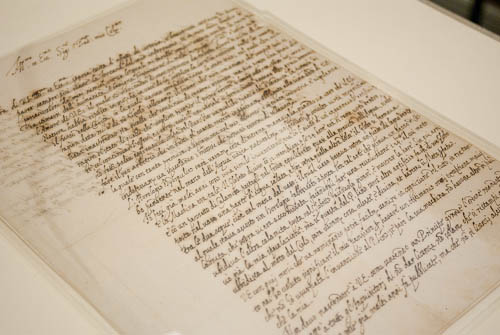Would you like to see Galileo’s hand-writing?—I asked a visiting friend who came to see highlights of the Dibner Library in the Smithsonian Institution Libraries the other day. In the age of mobile devices, email messages, texting and the many other forms of digital communication are we still interested in the way someone writes by hand? Does that provide any other kind of information besides the text?
These questions came to me much later because my friend very quickly answered “yes” to my first question. So, I headed to the temperature and humidity controlled secure stacks to the manuscript section, where the library holds the ca. 1600 manuscript groups that were donated to the Smithsonian by Bern Dibner, 20th century engineer, inventor and science historian, in 1976. I carefully removed the folder that contains the letter from the archival storage box and took it to the reading room where my friend was sitting. I told him about the content of the letter and its story which is interesting.
Galileo wrote this letter on May 12th, 1635 (in Italian) replying to his colleague and supporter, the French amateur mathematician and natural philosopher, Nicolaus Claude Fabri de Preiresc. Their correspondence had started years earlier mainly about Preiresc’s repeated appeals to Cardinal Barberini (Pope Urban VIII) to lighten the restrictions of Galileo’s house arrest he was under due to his sentence at his 1633 trial. The letters (as this particular one too) discussed scientific topics as well, among them a curious water clock developed by Franciscus Linus in Liège. The clock consisted of a small globe balancing and rotating in water contained in a larger round vessel. Next to the globe was a small fish hovering in the water and pointing to the numbers on the small globe showing the hour of the day. According to the letter, the clock was driven by a mysterious magnetic force. Galileo used the occasion of discussing Linus’s water clock to describe his own similar model that he developed some years earlier. Then he quickly added: “I, meanwhile, have wished to indicate […] that I have not usurped the invention from Father Linus—if indeed his machine does not have any more to it than mine.”
“Beautiful, even hand-writing”—said my friend looking at the letter—“It does not bespeak about a crushed, oppressed old man’s state of mind.” And this should remind us that, in fact, Galileo did not suffer in the casemates of the Inquisition, since he revoked some of his scientific ideas. This made it possible for him to have a prolific time during his years following the trial and publish one of his most significant works, the Discourses concerning two new sciences. The book, published in Leyden in 1638, is considered by many Galileo’s main contribution to physics, in which he laid down the foundations of the modern science of dynamics.
—Lilla Vekerdy



One Comment
Who at the Smithsonian could I reach out to to look at a manuscript for me with writing eerily similar to Galileo and is on the subject Of the planetary orbits including tychonic, copernican and Ptolemaic stystems…?